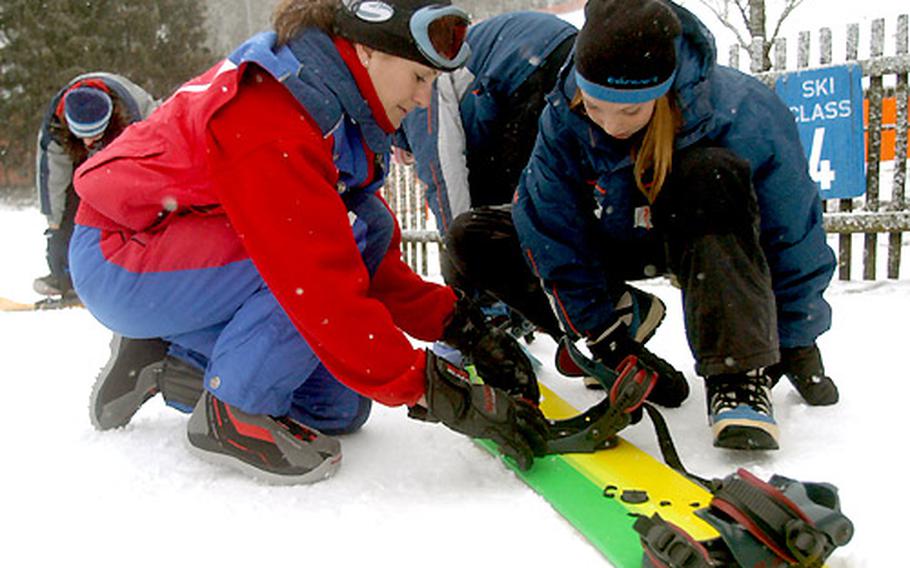
Patricia Joy, a snowboarding instructor at the Hausberg Lodge in Garmisch, Germany, helps Samantha Voltoline, 13, put on her snowboard for the first time during an instruction class. Joy had Voltoline begin on the snowboard on level ground and with only one foot in the bindings. (Jessica Inigo / S&S)
Any poser could jump into some K2 gear and look like a snowboarder, but it takes a little more finesse to pull it off on the slopes.
Snowboarding is still a relatively new winter sport, and each winter more beginners take it up.
This year, learn some moves before hitting the slopes by practicing in a snowy lot or with the last bit of winter snow in the back yard. And learn the lingo so you sound like you know what you are talking about.
Below is a 10-point guide to look and sound like a bunny slope graduate that I pass along after taking a class from Patricia Joy, a snowboarding instructor at the Armed Forces Recreation Center’s Hausberg Lodge in Garmisch, Germany. She knows quite a bit about the sport, and if you spend some time with her, you can’t help but pick up some of her knowledge.
¶ Know the gear. Slalom or alpine boards are stiff, narrow and long. They are designed for high speeds and fast turns. Freestyle or halfpipe snowboards are not as stiff, shorter and are designed for balance and tricks.
Another thing to consider is how the gear works with the body. There are symmetrical and asymmetrical boards; hard and soft bindings; tip, tail and side cuts; regular foot and goofy foot; slalom board, free-style board and retention straps.
At a minimum, snowboarders should know if they lead with their left (regular foot) or right (goofy foot). Also learn how to secure boots to bindings and how to attach the leash before heading to the slopes.
Boots for alpine/slalom boards have a hard plastic exterior with extensive foot and ankle support. Boots for free-style/halfpipe boards have a soft exterior with foot and ankle support and lace-up inner boots. Plate bindings are used to attach boots to alpine boards, while straps or cleats are used to attach boots to halfpipe boards.
Snowboarders wear lightweight, form-fitting clothing designed for water and wind resistance, as well as warmth. Also, goggles are a good idea.
¶ Talk the talk. Get to know terms such as straight glide, heel and toe sideslip, falling leaf, skidded traverse, garlands and skidded turns.
¶ Know the environment. Prepare for the mountain and snow environment. Environmental safety issues, such as proper clothing to stay warm and working out in high altitudes should be considered before getting on the gondola and taking that first trip down the mountain.
¶ Begin. First, master level-terrain maneuvers. Learn basic moves with only the front foot in the binding: walking, stationary turning, climbing and skating. Decide if your personal style is regular or goofy foot, free-style or slalom.
Orient yourself to your equipment by getting in the snow and making efficient balancing upright stances. Practice sitting position, kneeling position and then roll over between kneeling and sitting position with the snowboard.
And, learn to fall. Everyone takes a tumble sometime, and it helps to know how to do it right and how to get up after a spill without looking really silly.
¶ Get moving. Start with straight gliding in a balanced, upright stance. It is common for beginners to spend time with the rear foot out of the binding to aid in balance development and proper position.
Practice short downhill turns by getting a good stance with weight forward, hands forward, head up and leaning. Next, press and twist to toe side (toe side skidded turn), lean, press and twist to heel side (heel side skidded turn).
¶ Control. Moves are about maintaining control. Sideslipping: controlling slipping speed by edging, both toe and heel edge. Falling leaf: controlling the direction of sideslipping. Traversing: both toe and heel side, without necessarily holding the edge, forward and backward skidding traverses.
¶ Do the moves. Remember to stretch and warm up first, as with any exercise, and then get on the board, shifting your weight from front to back and then heel to toe. Next try counter rotating your upper body with respect to your lower body, always remember to lean and look in the direction of the turn.
¶ Practice makes perfect. Continue practicing until you’re comfortable on the board and proper pressure becomes almost second nature for different moves and turns. Remember to get turns down by twisting the upper body in the direction of the turn. Add a little front-foot toe and rear-foot heel pressure to help the toe side turn. Add a little front-foot heel and rear-foot toe pressure for the heel side turn.
¶ To the slopes. To keep from looking like a newbie on the slopes, when the snowboard is not attached always keep it top down in the snow to protect it from sliding away — an obvious beginner faux pas. When sitting on trails, stay to the side and out of way. Plus, always remember to sit looking up the hill to remain aware of oncoming snowboarders.
Practice and familiarity are essential to looking like a pro, says Joy, who has been teaching these techniques to snowboarders and skiers for five years.
Joy, who is originally from Perry, Iowa, says beginners shouldn’t worry about taking a fall.
“It really doesn’t matter if you don’t get it for the first few days,” she says. “In about a week you’ll start figuring it out and things will become easier.”
She suggests beginners take it easy and have fun getting used to the snowboard and the slopes. “In no time beginners advance,” she says. “They pick it up so quick.”